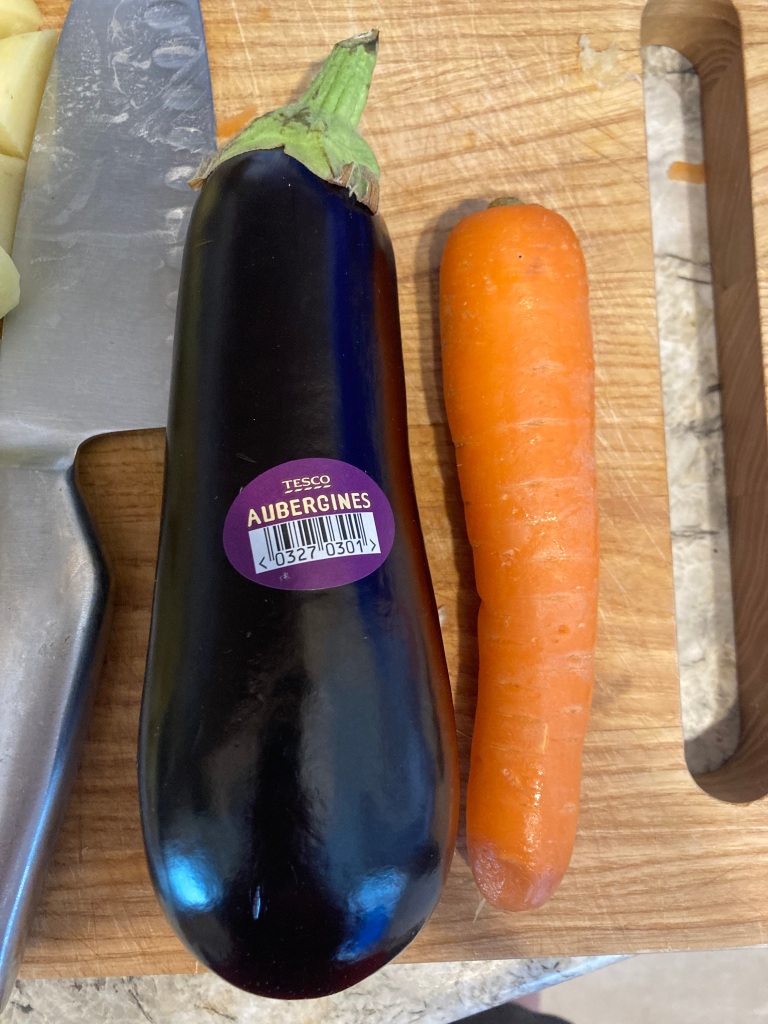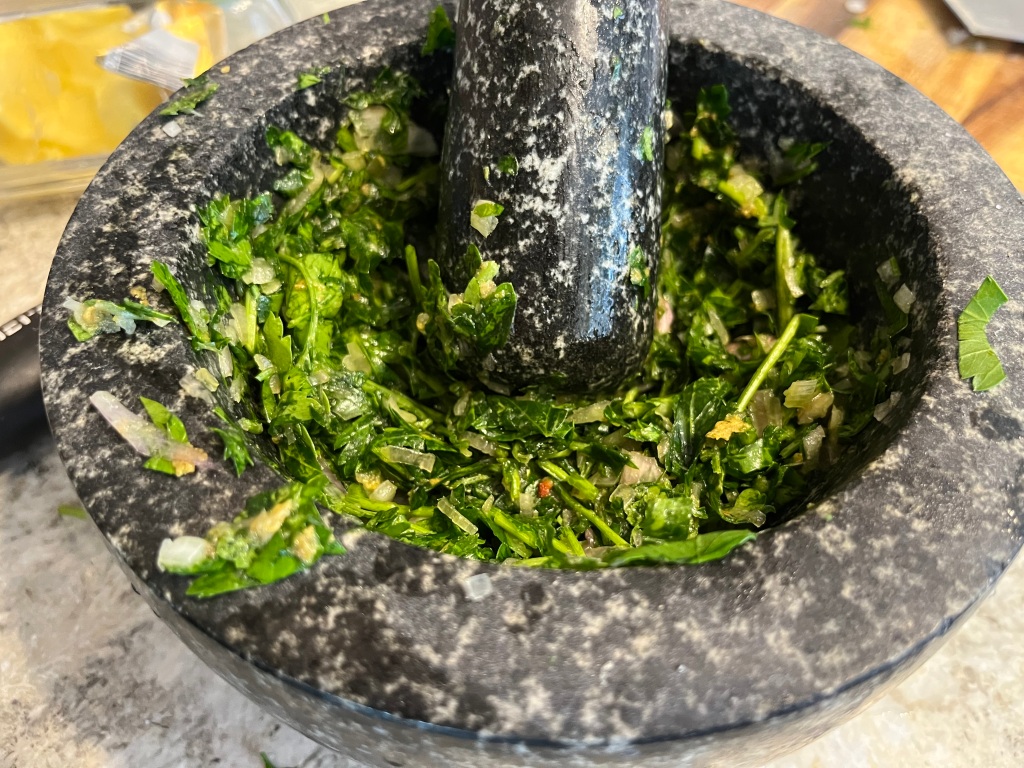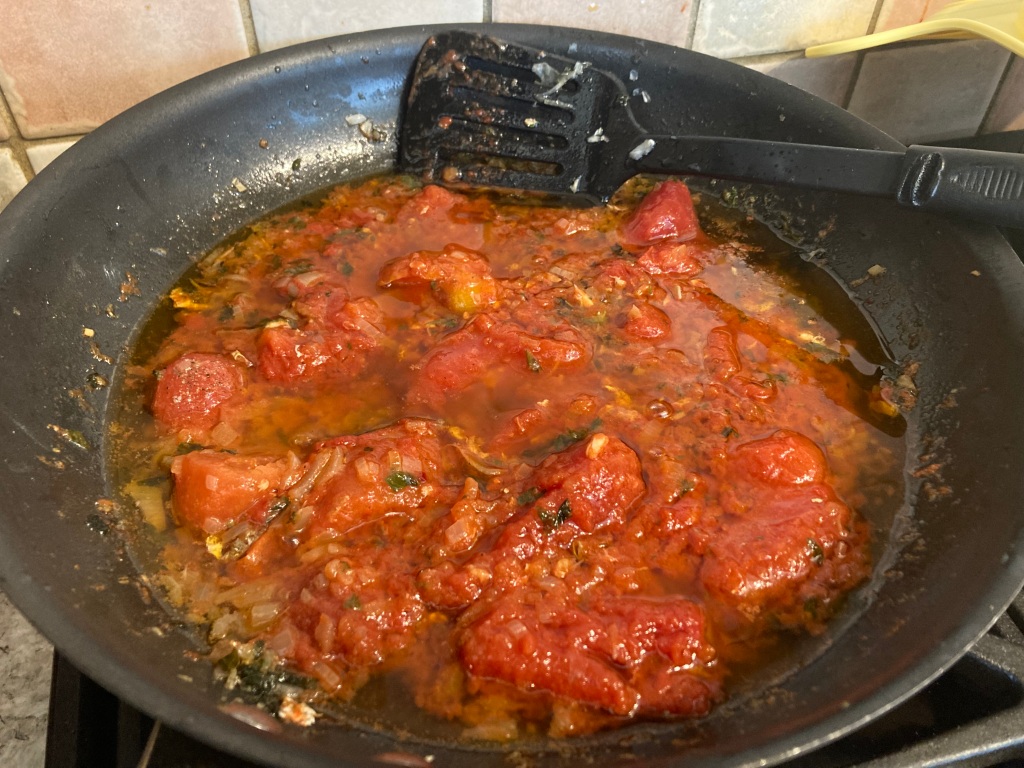When we made Ghanaian jollof rice, we mentioned that we planned to revisit jollof rice when we got to Senegal. This is because according to most sources, Senegal is where this popular dish originated, and, in fact, UNESCO has put Senegalese jollof on its ‘representative list of the intangible cultural heritage of humanity’. We weren’t going to argue with that.
What we weren’t prepared for is the fact that Senegalese jollof rice is very, very different from the Ghanaian version. Ghanaian jollof was tomatoey rice with some frozen veg thrown in. Senegalese jollof is also known as thieboudienne and is an elaborate fish, vegetable and rice situation that takes a lot longer to cook. (Thieboudienne is also the national dish of Mauritania, incidentally, but we’ll cross that bridge when we come to it.) We did briefly consider making something else, but if we were being honest with ourselves we had to admit that we’d already committed to thieboudienne… so that was that.
The next hurdle, though, was some of the ingredients. According to 196 Flavors, a traditional Senegalese jollof contains three ingredients we were unfamiliar with: nététou, guedj and yété. Nététou is also known as fermented seeds from the African locust bean tree and is described as having a ‘funky smell’. It can apparently be compared with miso paste. Guedj is salted and dried fish. Yété is mollusc flesh that has been fermented in the sand.
We might have been unfamiliar with these ingredients but what we are very familiar with is the palates of our children. This left us with a dilemma: should we go to the African supermarket to try to find these ingredients in order to make the dish as authentic as possible, but run the risk that the junior Mashes refuse to eat it? Or save ourselves the journey and also the frustration of trying to get a 4-year-old and a 1-year-old to eat a dish flavoured with fermented beans, dried fish and what can realistically only be described as rotten inverterbrate?
Reader, forgive us. We chose the path of least resistance. Read on to find out if it was worth it.
Thieboudienne
Ingredients
3-4 lean whole fish with firm flesh, cleaned and scored (traditionally grouper; bass, sea bream, pike, hake, tilapia or snapper would also be acceptable; we used bass)
1 bunch of parsley, chopped
2 shallots, minced
4 cloves of garlic, minced
4 habanero or Scotch Bonnet peppers, chopped (unsurprisingly, we also left these out)
2 beef or vegetable stock cubes (we used vegetable)
1 1-inch piece of nététou
2 small guedj
1 cup vegetable oil
1 onion, chopped
4 tbsp tomato puree
1 tin of peeled plum tomatoes
4 bay leaves
2 carrots, peeled and cut into chunks
2 potatoes, peeled and cut into chunks
1 aubergine, thickly sliced
1 cabbage, cut into wedges
1 cassava root, peeled and cut into chunks (we didn’t have any cassava so used some swede… the veg can be pretty approximate)
6 okras
4 cups broken rice (or long grain rice, which is what we used)
1 lime, sliced
Salt and pepper
Method
1. Prepare the fish stuffing by mixing the parsley, 2 garlic cloves, shallots, 2 hot peppers, 1 stock cube and some salt in a mortar and pestle. Set aside.
2. Stuff each of the scored cuts in the fish with the mixture.
3. Heat the vegetable oil in a deep skillet or Dutch oven and fry the fish for 6-7 minutes on each side. Set aside.
4. Reduce the heat and add the remaining 2 garlic cloves, remaining 2 peppers and onion. Cook for 5 minutes.
5. Meanwhile, grind the remaining stock cube, nététou and guedj using a food processor.
6. Add the powder, tomato puree and tinned tomatoes to the pan and season. Simmer for 5 minutes.
7. Add the bay leaves and 250ml water. Simmer for 15 minutes over low heat.
8. Add the vegetables and simmer for 30 minutes. Remove the vegetables as they are cooked through but still firm and reserve.
9. Add the rice and enough water to cover the rice (we added 1500ml at this point, and another 250ml later in the cook when the rice was still too crunchy).
10. Cook for 20-30 minutes uncovered, stirring occasionally to stop it from sticking. (At around the 25 minute mark we tried it but the rice was still crunchy. This is when we added the extra water; we also cooked it with the lid on for another 5 minutes or so.)
11. Add the vegetables and fish back to the pan (or, like us, transfer everything to a more enormous pan) and cook for an additional 5 minutes.
12. Serve hot with lime slices.
Serves 6-8
Normally we would post photos of the cooking process at this point but before we do that, we’re going to have another whinge about Tesco’s produce. Look at this pathetic excuse for an aubergine we were forced to work with (carrot for scale):

Anyway, here’s what the dish looked like:







Time for a bigger pan…


Please excuse the hurried presentation (including the lack of lime) — hangry children were waiting…
So — was it worth making an unusually ‘processy’ dish just because UNESCO said so? And was it worth making it inauthentically so the kids would eat it?
The answer to the first question, we think, is yes. It did take a lot longer to prepare and cook than anything else we’ve made recently, but it’s so iconic, it had to be done. We very rarely cook fresh fish like that so that was a nice treat, and the fish combined with all the different vegetables meant there was a lot more variety in each mouthful than there was in the Ghanaian jollof.
As for the second question… we’re not sure. The kids did both eat some of it (which is good because we made enough to feed the 5000), so that was a victory. But there’s no way we can claim to know what Senegalese jollof tastes like, despite the amount of time and effort we spent on it. This might have to be another addition to the ‘try it again one day’ list.
